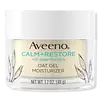What's inside
What's inside
 Key Ingredients
Key Ingredients

 Benefits
Benefits

 Concerns
Concerns

 Ingredients Side-by-side
Ingredients Side-by-side

Water
Skin ConditioningOctyldodecyl Neopentanoate
EmollientDicaprylyl Carbonate
EmollientGlycerin
HumectantBehenyl Alcohol
EmollientGlycine Soja Seed Extract
Skin ConditioningMangifera Indica Seed Butter
Skin ConditioningGlyceryl Stearate
EmollientCandelilla/Jojoba/Rice Bran Polyglyceryl-3 Esters
EmulsifyingVinyl Dimethicone/Methicone Silsesquioxane Crosspolymer
Potassium Cetyl Phosphate
EmulsifyingNiacinamide
SmoothingPhenoxyethanol
PreservativeSodium Stearoyl Lactylate
EmulsifyingCetearyl Alcohol
EmollientMicrocrystalline Cellulose
AbsorbentCaprylyl Glycol
EmollientParfum
MaskingMagnesium Aluminum Silicate
AbsorbentChlorphenesin
AntimicrobialCetyl Hydroxyethylcellulose
Emulsion StabilisingDisodium EDTA
Tocopheryl Acetate
AntioxidantSodium PCA
HumectantUrea
BufferingEthylhexylglycerin
Skin ConditioningCellulose Gum
Emulsion StabilisingGlyceryl Acrylate/Acrylic Acid Copolymer
HumectantTrehalose
HumectantHexylene Glycol
EmulsifyingPolyquaternium-51
Skin ConditioningTriacetin
AntimicrobialSodium Hyaluronate
HumectantTitanium Dioxide
Cosmetic ColorantWater, Octyldodecyl Neopentanoate, Dicaprylyl Carbonate, Glycerin, Behenyl Alcohol, Glycine Soja Seed Extract, Mangifera Indica Seed Butter, Glyceryl Stearate, Candelilla/Jojoba/Rice Bran Polyglyceryl-3 Esters, Vinyl Dimethicone/Methicone Silsesquioxane Crosspolymer, Potassium Cetyl Phosphate, Niacinamide, Phenoxyethanol, Sodium Stearoyl Lactylate, Cetearyl Alcohol, Microcrystalline Cellulose, Caprylyl Glycol, Parfum, Magnesium Aluminum Silicate, Chlorphenesin, Cetyl Hydroxyethylcellulose, Disodium EDTA, Tocopheryl Acetate, Sodium PCA, Urea, Ethylhexylglycerin, Cellulose Gum, Glyceryl Acrylate/Acrylic Acid Copolymer, Trehalose, Hexylene Glycol, Polyquaternium-51, Triacetin, Sodium Hyaluronate, Titanium Dioxide
Water
Skin ConditioningGlycerin
HumectantDimethicone
EmollientCetearyl Olivate
Avena Sativa Kernel Flour
AbrasiveSorbitan Olivate
EmulsifyingPolyacrylamide
Synthetic Beeswax
Emulsion StabilisingPhenoxyethanol
PreservativeC13-14 Isoparaffin
EmollientButylene Glycol
HumectantDimethicone Crosspolymer
Emulsion StabilisingPanthenol
Skin ConditioningChlorphenesin
AntimicrobialDimethiconol
EmollientCarbomer
Emulsion StabilisingLaureth-7
EmulsifyingChrysanthemum Parthenium Flower/Leaf/Stem Juice
AntioxidantEthylhexylglycerin
Skin ConditioningSodium Hydroxide
BufferingAvena Sativa Kernel Extract
AbrasiveCentella Asiatica Extract
CleansingWater, Glycerin, Dimethicone, Cetearyl Olivate, Avena Sativa Kernel Flour, Sorbitan Olivate, Polyacrylamide, Synthetic Beeswax, Phenoxyethanol, C13-14 Isoparaffin, Butylene Glycol, Dimethicone Crosspolymer, Panthenol, Chlorphenesin, Dimethiconol, Carbomer, Laureth-7, Chrysanthemum Parthenium Flower/Leaf/Stem Juice, Ethylhexylglycerin, Sodium Hydroxide, Avena Sativa Kernel Extract, Centella Asiatica Extract
 Reviews
Reviews

Ingredients Explained
These ingredients are found in both products.
Ingredients higher up in an ingredient list are typically present in a larger amount.
Chlorphenesin is a synthetic preservative. It helps protect a product against bacteria in order to extend shelf life. In most cases, Chlorphenesin is paired with other preservatives such as phenoxyethanol and caprylyl glycol.
Chlorphenesin is a biocide. This means it is able to help fight the microorganisms on our skin. It is also able to fight odor-releasing bacteria.
Chlorphenesin is soluble in both water and glycerin.
Studies show Chlorphenesin is easily absorbed by our skin. You should speak with a skincare professional if you have concerns about using Chlorphenesin.
Learn more about ChlorphenesinEthylhexylglycerin (we can't pronounce this either) is commonly used as a preservative and skin softener. It is derived from glyceryl.
You might see Ethylhexylglycerin often paired with other preservatives such as phenoxyethanol. Ethylhexylglycerin has been found to increase the effectiveness of these other preservatives.
Glycerin is already naturally found in your skin. It helps moisturize and protect your skin.
A study from 2016 found glycerin to be more effective as a humectant than AHAs and hyaluronic acid.
As a humectant, it helps the skin stay hydrated by pulling moisture to your skin. The low molecular weight of glycerin allows it to pull moisture into the deeper layers of your skin.
Hydrated skin improves your skin barrier; Your skin barrier helps protect against irritants and bacteria.
Glycerin has also been found to have antimicrobial and antiviral properties. Due to these properties, glycerin is often used in wound and burn treatments.
In cosmetics, glycerin is usually derived from plants such as soybean or palm. However, it can also be sourced from animals, such as tallow or animal fat.
This ingredient is organic, colorless, odorless, and non-toxic.
Glycerin is the name for this ingredient in American English. British English uses Glycerol/Glycerine.
Learn more about GlycerinPhenoxyethanol is a preservative that has germicide, antimicrobial, and aromatic properties. Studies show that phenoxyethanol can prevent microbial growth. By itself, it has a scent that is similar to that of a rose.
It's often used in formulations along with Caprylyl Glycol to preserve the shelf life of products.
Water. It's the most common cosmetic ingredient of all. You'll usually see it at the top of ingredient lists, meaning that it makes up the largest part of the product.
So why is it so popular? Water most often acts as a solvent - this means that it helps dissolve other ingredients into the formulation.
You'll also recognize water as that liquid we all need to stay alive. If you see this, drink a glass of water. Stay hydrated!
Learn more about Water